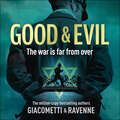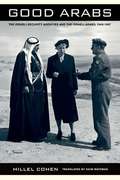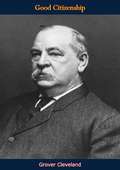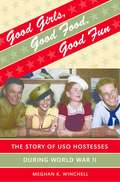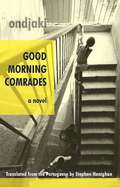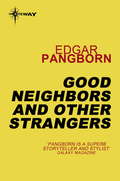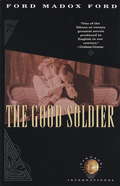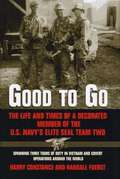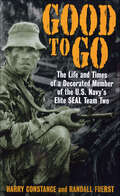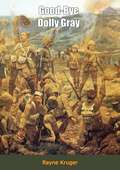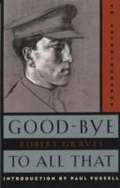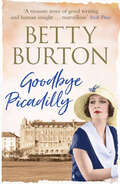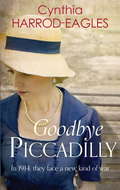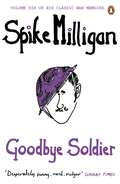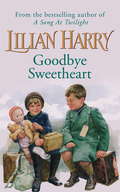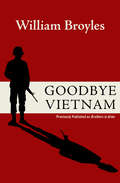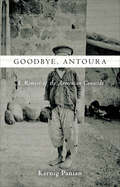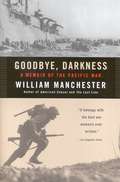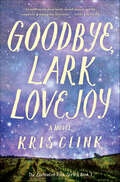- Table View
- List View
Good & Evil: The Black Sun Trilogy, Book 2 (The Black Sun Series #2)
by Giacometti RavenneOUT NOW: the second volume in the bestselling, exhilarating WWII treasure-hunt thriller series for fans of Dan Brown*** RATED 5 STARS BY REAL READERS *** *** PREORDER BOOK 3, HELLBOUND, NOW: https://amz.run/3tyk ***November 1941. Germany is about to win the war. Only one thing still separates the Nazis from a certain victory: they must find the three remaining all-powerful swastikas and reunite them with a fourth that is safely hidden away in Himmler's mountain stronghold. Churchill has no choice but to mobilize his best man, double agent Tristan Marcas, and employ the most risky techniques to beat them to it. It all comes to a showdown at a ball in Venice...(P) 2020 Hodder & Stoughton Ltd
Good Arabs: The Israeli Security Agencies and the Israeli Arabs, 1948-1967
by Haim Watzman Hillel CohenExposing the full extent of the crucial, and, until now, willfully hidden history of Palestinian collaboration with Israelis and of the Arab resistance to it, the book brings together the stories of activists, mukhtars, collaborators, teachers, and sheikhs.
Good Citizenship
by Grover ClevelandMr. Cleveland’s address on Good Citizenship was delivered before the Commercial Club of Chicago in October, 1903; and that on Patriotism and Holiday Observance before the Union League Club, of the same city, on Washington’s Birthday, 1907.With Mr. Cleveland’s sanction, they appeared for the first time in book form in 1908—to help define what makes a good citizen.
Good Girls, Good Food, Good Fun
by Meghan K. WinchellThroughout World War II, when Saturday nights came around, servicemen and hostesses happily forgot the war for a little while as they danced together in USO clubs, which served as havens of stability in a time of social, moral, and geographic upheaval. Meghan Winchell demonstrates that in addition to boosting soldier morale, the USO acted as an architect of the gender roles and sexual codes that shaped the "greatest generation."Combining archival research with extensive firsthand accounts from among the hundreds of thousands of female USO volunteers, Winchell shows how the organization both reflected and shaped 1940s American society at large. The USO had hoped that respectable feminine companionship would limit venereal disease rates in the military. To that end, Winchell explains, USO recruitment practices characterized white middle-class women as sexually respectable, thus implying that the sexual behavior of working-class women and women of color was suspicious. In response, women of color sought to redefine the USO's definition of beauty and respectability, challenging the USO's vision of a home front that was free of racial, gender, and sexual conflict.Despite clashes over class and racial ideologies of sex and respectability, Winchell finds that most hostesses benefited from the USO's chaste image. In exploring the USO's treatment of female volunteers, Winchell not only brings the hostesses' stories to light but also supplies a crucial missing piece for understanding the complex ways in which the war both destabilized and restored certain versions of social order.
Good Morning Comrades
by Stephen Henighan OndjakiThe first publication in English by one of the most talented, prolific and celebrated novelists in Africa, Ondjaki's Good Morning Comrades looks at the calm before the storm of the Angolan Civil War from the perspective of a young boy. Translated from the Portuguese.
Good Neighbors and Other Strangers
by Edgar PangbornIn the corner gas station, the local saloon, on the down-east farm, in the settings of EVERYDAY - there appear UNEXPECTEDLY THE ALIEN, THE WEIRD, THE MYSTERIOUSThe title story tells of one tearful stray from a herd of alien livestock which crushes most of Manhattan and causes apologetic herders to make amends. There is a shivery novelette about the abduction of a country wife by a hairy beast, and the story of a pickup truck full of mythical characters asking directions to Olympus. Then there are the ten-legged blue bugs from inner - or outer - space that can give you a dream - or a nightmare; the shadow-monkeys who have the absurd habit of following along and changing by what you think; the tiny angel that hatches from an egg; and the 'wrens' that hatch from Grandpa's beard the summer he was 106.
Good Night, Irene: A Novel
by Luis Alberto UrreaAn Instant New York Times Bestseller This &“powerful, uplifting, and deeply personal novel&” (Kristin Hannah, #1 NYT bestselling author of The Four Winds), at once &“a heart-wrenching wartime drama&” (Christina Baker Kline, #1 NYT bestselling author of Orphan Train) and &“a moving and graceful tribute to heroic women&” (Publishers Weekly, starred review), asks the question: What if a friendship forged on the front lines of war defines a life forever? In the tradition of The Nightingale and Transcription, this is a searing epic based on the magnificent and true story of courageous Red Cross women. &“Urrea&’s touch is sure, his exuberance carries you through . . . He is a generous writer, not just in his approach to his craft but in the broader sense of what he feels necessary to capture about life itself.&” —Financial Times In 1943, Irene Woodward abandons an abusive fiancé in New York to enlist with the Red Cross and head to Europe. She makes fast friends in training with Dorothy Dunford, a towering Midwesterner with a ferocious wit. Together they are part of an elite group of women, nicknamed Donut Dollies, who command military vehicles called Clubmobiles at the front line, providing camaraderie and a taste of home that may be the only solace before troops head into battle. After D-Day, these two intrepid friends join the Allied soldiers streaming into France. Their time in Europe will see them embroiled in danger, from the Battle of the Bulge to the liberation of Buchenwald. Through her friendship with Dorothy, and a love affair with a courageous American fighter pilot named Hans, Irene learns to trust again. Her most fervent hope, which becomes more precarious by the day, is for all three of them to survive the war intact. Taking as inspiration his mother&’s own Red Cross service, Luis Alberto Urrea has delivered an overlooked story of women&’s heroism in World War II. With its affecting and uplifting portrait of friendship and valor in harrowing circumstances, Good Night, Irene powerfully demonstrates yet again that Urrea&’s &“gifts as a storyteller are prodigious&” (NPR).
Good Soldier
by Ford Madox FordAt the fashionable German spa town Bad Nauheim, two wealthy, fin de siecle couples -- one British, the other American -- meet for their yearly assignation. As their story moves back and forth in time between 1902 and 1914, the fragile surface propriety of the pre -- World War I society in which these four characters live is ruptured -- revealing deceit, hatred, infidelity, and betrayal. "The Good Soldier" is Edward Ashburnham, who, as an adherent to the moral code of the English upper class, is nonetheless consumed by a passion for women younger than his wife -- a stoic but fallible figure in what his American friend, John Dowell, calls "the saddest story I ever heard." From the Trade Paperback edition.
Good to Go!
by Harry Constance Randall FuerstIn 1966 Harry Constance became a member of the newly formed U.S. Navy SEALS TEAM II. By 1970 he was a veteran of 300 combat missions in Vietnam, had captured almost two hundred enemy prisoners, and had received 32 citations, including three bronze stars and a purple heart. In Good To Go, Constance powerfully recounts his experience during three tours in Vietnam as a member of Seal Team II, Seventh Platoon. Known as fierce warriors with amazing stealth and skill in battle, the Seals are an elite force trained to fight on sea, air, and land with sophisticated special operation warfare tactics. Made famous by Richard Marcinko's Rogue Warrior Books, here is a behind-the-scenes look at what Seal combat was really like. From the flood plains of the Mecong Delta to the beaches of the south China Sea, Good To Go takes readers on Constance's harrowing missions, along trails crisscrossed by trip wires and through dense jungles booby-trapped with live grenades. Each "Special Op" is dramatic: the Seventh Platoon sets up ambushes, infiltrates Viet Cong territory, preforms daring nighttime attacks, targets the location of high-level VC Officials, and narrowly escapes enemy fire. Constance gives an extra ordinary account of the Tet offensive, which his platoon fought from a hotel Mi Tho. But in recounting the ferocious battle of Tet, Constance shows why Seal humor and bravado always won the day. After Constance leaves Vietnam, Good To Go follows him as he plays a key role in the expansion of the Seal program. His duty training recruits for undercover clandestine Ops and going on dangerous assignments around globe - in South America hot spots and onboard nuclear submarines - reflects his inspiring dedication to the Seals. Constance's unforgettable memoir reveals the loyalty, bravery, and honor behind the Seal mystique. Packed with astonishing descriptions of the Seals real-life adventure in the deadliest of war zones, Good To Go captures the heroism and profound courage that have made the Seals legendary.
Good to Go: The Life And Times Of A Decorated Member of the U.S. Navy's Elite Seal Team Two
by Randall Fuerst Harold Constance"Fractions of a second in time. What amazing violence can be meted out in the blink of an eye."In the mid-nineteen sixties, Harry Constance made a life-altering journey that led him out of Texas and into the jungles of Vietnam. As a young naval officer, he went from UDT training to the U.S. Navy's newly formed SEAL Team Two, and then straight into furious action. By 1970, he was already the veteran of three hundred combat missions and the recipient of thirty-two military citations, including three Bronze Stars and a Purple Heart.Good To Go is Constance's powerful, firsthand account of his three tours of duty as a member of America's most elite, razor-sharp stealth fighting force. It is a breathtaking memoir of harrowing missions and covert special-ops—from the floodplains of the Mekong Delta to the beaches of the South China Sea—that places the reader in the center of bloody ambushes and devastating firefights. But his extraordinary adventure goes even farther—beyond 'Nam—as we accompany Constance and the SEALs on astonishing missions to some of the world's most dangerous hot-spots . . . and experience close-up the courage, dedication, and unparalleled skill that made the U.S. Navy SEALs legendary.Includes 8 Pages of SEAL Team Action Photos!
Good-Bye Dolly Gray: The Story Of The Boer War
by Rayne KrugerIt was natural for the South African-born writer Rayne Kruger to choose the Boer War for a work of non-fiction. Settled in England, he returned to Johannesburg to interview survivors and consult written records, and Goodbye Dolly Gray, first published in 1959, went on to become the first modern one-volume distillation of existing knowledge on the South African War, concentrating on the campaigning while being mindful of the political consequences for all concerned.Rayne Kruger brilliantly describes the background, the arms and armies, the campaigns and personalities of the war in which soldiers from across the British Empire marched to a succession of brave defeats at hands of sharpshooting farmers. Goodbye Dolly Gray places the glory and the savagery of the South African war into the perspective of modern Africa.“His organization of his vast material is masterly”—TIMES LITERARY SUPPLEMENT“At a time when South Africa and its racial crisis make daily news, this highly readable, lively history recreates the long, grim years of the Boer War […] Th[is] book tells it all. Paul Kruger, Cecil Rhodes, Joseph Chamberlin, Winston Churchill, the Kaiser, General Kitchener, and many others appear as central or fascinating peripheral figures in the telling. And the great battles of Natal and Ladysmith come alive again with exciting, dust-boiling, brutal verisimilitude. Nor are the political forces behind these years of chaotic fighting neglected. The result is an entertaining, instructive historical work of the first order.”—KIRKUS REVIEW
Good-bye To All That: An Autobiography
by Robert GravesIn this autobiography, first published in 1929, poet Robert Graves traces the monumental and universal loss of innocence that occurred as a result of the First World War. Written after the war and as he was leaving his birthplace, he thought, forever,Good-Bye to All That bids farewell not only to England and his English family and friends, but also to a way of life. Tracing his upbringing from his solidly middle-class Victorian childhood through his entry into the war at age twenty-one as a patriotic captain in the Royal Welsh Fusiliers, this dramatic, poignant, often wry autobiography goes on to depict the horrors and disillusionment of the Great War, from life in the trenches and the loss of dear friends, to the stupidity of government bureaucracy and the absurdity of English class stratification. Paul Fussell has hailed it as ""the best memoir of the First World War"" and has written the introduction to this new edition that marks the eightieth anniversary of the end of the war. An enormous success when it was first issued, it continues to find new readers in the thousands each year and has earned its designation as a true classic.
Goodbye Piccadilly
by Betty BurtonIn this coming-of-age novel, &“a treasure trove of good writing and human insight&” three friends grapple with romance and women&’s suffrage during WWI (The Irish Press). From the author of the Lu Wilmott series, a stunning saga of friendship, ambition, and love. Otis Hewetson is seventeen years old, pretty but unconventional and rebellious. She spends the summer of 1911 on a glorious holiday with her parents, and on a quest for independence. But little does she realize how her new friendships with Jack and Esther will change her life forever. Their paths are destined to cross as they grow from adolescence through to marriage, the fight for women&’s rights and the bitter bloodshed of the Great War . . . &“It is encouraging when someone like Betty Burton manages against the odds to become a roaring success.&” —The Guardian
Goodbye Piccadilly: War at Home, 1914 (War at Home #1)
by Cynthia Harrod-EaglesIn 1914, Britain faces a new kind of war. For Edward and Beatrice Hunter, their children, servants and neighbours, life will never be the same again. Perfect for fans of Downton Abbey and Barbara Taylor-Bradford.For David, the eldest, war means a chance to do something noble; but enlisting will break his mother's heart. His sister Diana, nineteen and beautiful, longs for marriage. She has her heart set on Charles Wroughton, son of Earl Wroughton, but Charles will never be allowed to marry a banker's daughter. Below stairs, Cook and Ada, the head housemaid, grow more terrified of German invasion with every newspaper atrocity story. Ethel, under housemaid, can't help herself when it comes to men and now soldiers add to the temptation; yet there's more to this flighty girl than meets the eye.The once-tranquil village of Northcote reels under an influx of khaki volunteers, wounded soldiers and Belgian refugees. The war is becoming more dangerous and everyone must find a way to adapt to this rapidly changing world.Goodbye Piccadilly is the first book in the War at Home series by Cynthia Harrod-Eagles, author of the much-loved Morland Dynasty novels. Set against the real events of 1914, Goodbye Piccadilly is extraordinary in scope and imagination and is a compelling introduction to the Hunter family.
Goodbye Piccadilly: War at Home, 1914 (War at Home #1)
by Cynthia Harrod-EaglesIn 1914, Britain faces a new kind of war. For Edward and Beatrice Hunter, their children, servants and neighbours, life will never be the same again.For David, the eldest, war means a chance to do something noble; but enlisting will break his mother's heart. His sister Diana, nineteen and beautiful, longs for marriage. She has her heart set on Charles Wroughton, son of Earl Wroughton, but Charles will never be allowed to marry a banker's daughter. Below stairs, Cook and Ada, the head housemaid, grow more terrified of German invasion with every newspaper atrocity story. Ethel, under housemaid, can't help herself when it comes to men and now soldiers add to the temptation; yet there's more to this flighty girl than meets the eye.The once-tranquil village of Northcote reels under an influx of khaki volunteers, wounded soldiers and Belgian refugees. The war is becoming more dangerous and everyone must find a way to adapt to this rapidly changing world.Goodbye Piccadilly is the first book in the War at Home series by Cynthia Harrod-Eagles, author of the much-loved Morland Dynasty novels. Set against the real events of 1914, Goodbye Piccadilly is extraordinary in scope and imagination and is a compelling introduction to the Hunter family.
Goodbye Soldier (Spike Milligan War Memoirs)
by Spike MilliganSpike Milligan's legendary war memoirs are a hilarious and subversive first-hand account of the Second World War, as well as a fascinating portrait of the formative years of this towering comic genius, most famous as writer and star of The Goon Show. They have sold over 4.5 million copies since they first appeared.'The most irreverent, hilarious book about the war that I have ever read' Sunday Express'Brilliant verbal pyrotechnics, throwaway lines and marvelous anecdotes' Daily Mail'Desperately funny, vivid, vulgar' Sunday Times'My namer is Maria Antonoinetta Fontana, but everyone call me Toni.' 'I'm Spike, sometimes known as stop thief or hey you.' 'Yeser, I know.' The sixth volume of Spike Milligan's off-the-wall account of his part in World War Two sees our hero doing very little soldiering. Because it's 1946. Rather, he is now part of the Bill Hall Trio - a 'Combined Services Entertainment' inflicted on unsuspecting soldiers across Italy and Austria - and is largely preoccupied with the unbearably beautiful ballerina, Ms Toni Fontana ('Arghhhhhhhhh!). But he must enjoy it while he can before he is demobbed and sent home to Catford - so he does ...'That absolutely glorious way of looking at things differently. A great man' Stephen Fry'Milligan is the Great God to all of us' John Cleese'The Godfather of Alternative Comedy' Eddie Izzard'Manifestly a genius, a comic surrealist genius and had no equal' Terry Wogan'A totally original comedy writer' Michael Palin'Close in stature to Lewis Carroll and Edward Lear in his command of the profound art of nonsense' GuardianSpike Milligan was one of the greatest and most influential comedians of the twentieth century. Born in India in 1918, he served in the Royal Artillery during WWII in North Africa and Italy. At the end of the war, he forged a career as a jazz musician, sketch-show writer and performer, before joining forces with Peter Sellers and Harry Secombe to form the legendary Goon Show. Until his death in 2002, he had success as on stage and screen and as the author of over eighty books of fiction, memoir, poetry, plays, cartoons and children's stories.
Goodbye Sweetheart
by Lilian HarryFrom the outbreak of the Second World War to the evacuation of Dunkirk, GOODBYE SWEETHEART follows the fortunes of the people who live in a working-class street in Portsmouth.Like any street, April Grove in Portsmouth has its good and bad neighbours, its gossip, scandal and romance. But the outbreak of war in 1939 changes everything - especially for the children. Uprooted from their familiar urban existence they are evacuated (some happily, some not) to the country. Then there are the teenagers, whose first loves are accelerated and intensified by the threat of separation; and men and women, too old to fight, who hold the life of the street together. Based on the author's own childhood memories of growing up near Portsmouth, this is a novel which shows us what England was really like then - a story told with such nostalgia and charm that you leave the world it describes longing for the chance to return.
Goodbye Vietnam
by William BroylesIn this &“essential&” memoir, a former marine returns to Vietnam years later to try to make sense of the war (Anthony Swofford, author of Jarhead). When William Broyles Jr. was drafted, he was a twenty-four-year-old student at Oxford University in England, hoping to avoid military service. During his physical exam, however, he realized that he couldn&’t let social class or education give him special privileges. He joined the marines, and soon commanded an infantry platoon in the foothills near Da Nang. More than a decade later, Broyles found himself flooded with emotion during the dedication of the Vietnam Veterans Memorial in Washington, DC. He decided to return to Vietnam and confront what he&’d been through. Broyles was one of the very first combat veterans to return to the battlefields. No American before or since has gone so deeply into the other side of the war: the enemy side. Broyles interviews dozens of Vietnamese, from the generals who ran the war to the men and women who fought it. He moves from the corridors of power in Hanoi—so low-tech that the plumbing didn&’t work—to the jungles and rice paddies where he&’d fought. He meets survivors of American B-52 strikes and My Lai, and grieves with a woman whose son was killed by his own platoon. Along the way, Broyles also explores the deep bonds he shared with his own comrades, and the mystery of why men love war even as they hate it. Amidst the landscape of death, his formerly faceless enemies come to life. They had once tried to kill each other, but they are all brothers now. Previously published as Brothers in Arms, this edition includes a new preface by the author.
Goodbye, Antoura: A Memoir of the Armenian Genocide
by Karnig Panian translated by Simon Beugekian edited by Aram GoudsouzianWhen World War I began, Karnig Panian was only five years old, living among his fellow Armenians in the Anatolian village of Gurin. Four years later, American aid workers found him at an orphanage in Antoura, Lebanon. He was among nearly 1,000 Armenian and 400 Kurdish children who had been abandoned by the Turkish administrators, left to survive at the orphanage without adult care. This memoir offers the extraordinary story of what he endured in those years-as his people were deported from their Armenian community, as his family died in a refugee camp in the deserts of Syria, as he survived hunger and mistreatment in the orphanage. The Antoura orphanage was another project of the Armenian genocide: its administrators, some benign and some cruel, sought to transform the children into Turks by changing their Armenian names, forcing them to speak Turkish, and erasing their history. Panian's memoir is a full-throated story of loss, resistance, and survival, but told without bitterness or sentimentality. His story shows us how even young children recognize injustice and can organize against it, how they can form a sense of identity that they will fight to maintain. He paints a painfully rich and detailed picture of the lives and agency of Armenian orphans during the darkest days of World War I. Ultimately, Karnig Panian survived the Armenian genocide and the deprivations that followed. Goodbye, Antoura assures us of how humanity, once denied, can be again reclaimed.
Goodbye, Charley
by Jane BuchananForming bonds in a time of warIt's the summer of 1943, and for twelve-year-old Celie Marsh the war seems awfully close to her coastal Massachusetts home. She worries about bombs and submarines, and about her big brother, who can't wait to go off and fight. Her little brother doesn't seem to need her anymore, and her best friend has moved away. When her father brings Charley, a monkey, home from work one day, Celie finds the comforting companion she has been missing. But more upheaval is in store: irritating Joey Bentley moves in with his crabby grandmother next door, her mother takes a job building warships, and worst of all, Charley proves to be too wild for Celie to manage. A near disaster forces Celie to make a heart-wrenching decision that teaches her painful lessons about friendship, family, and the meaning of love.This tender novel about relationships, based on the author's mother's experience, is elegantly crafted and suffused with warmth, as well as with a powerful sense of time and place.
Goodbye, Darkness: A Memoir of the Pacific War
by William R. ManchesterIn this intensely powerful memoir, America's preeminent biographer-historian, who has written so brilliantly about World War II in his acclaimed lives of General Douglas MacArthur (American Caesar) and Winston Churchill (The Last Lion), looks back at his own early life and offers an unrivaled firsthand account of World War II in the Pacific, of what it looked like, sounded like, smelled like, and, most of all, what it felt like to one who underwent all but the ultimate of its experiences.
Goodbye, Lark Lovejoy: A Novel
by Kris ClinkFor readers of Katherine Center and Kristan Higgins, an immersive, soul-nourishing novel that dares to hold onto hope when happily-ever-after seems lost. Full of character, wit, and wisdom, Goodbye, Lark Lovejoy explores second chances and the power of connection.Lark’s lost her husband, and the expiration date has come and gone on her fake-it-till-you-make-it “Happy Mommy Show.” Healing her broken family requires drastic measures—like returning to her hometown in the Texas Hill Country. But she’s going to need more than clean air and a pastoral landscape to rebuild a life for her and her young sons.After years of putting off her dream of becoming a winemaker, Lark puts every cent into a failing vineyard, determined to work through her grief and make a brighter future for her children. The last thing she expects is to fall in love again. Especially not with Wyatt Gifford, an injured Army vet with a past of his own to conquer.Coming home may not be the reset Lark imagined, but it does take her on a journey filled with humor and reconciliation—one that prepares her for a courageous comeback.
Goodbye, Mersey View
by Lyn AndrewsIn her nostalgic and heart-warming new saga, Sunday Times bestselling author Lyn Andrews evokes the ups and downs of life in the back streets of 1930s LiverpoolLiverpool, World War II. Monica Eustace and Joan McDonald met as next-door-neighbours living in Mersey View in Liverpool. Their friendship is a close as ever, though they're married now, and sharing Monica's grand house on the other side of the city. But war clouds are gathering, casting a shadow over the happy future they dream of with their young husbands . . . Meanwhile, in London, Joan's half-sister Bella is overwhelmed with the glitz and glamour of the city while she's training as a singer - but will she forget her friends back home? As war descends on Merseyside, can the women make their back street dreams reality, or will the close-knit families be torn apart?PRAISE FOR SUNDAY TIMES BESTSELLING AUTHOR LYN ANDREWS:'An outstanding storyteller' Woman's Weekly'Gutsy . . . A vivid picture of a hard-up, hard-working community . . . Will keep the pages turning' Daily Express'A compelling read' Woman's Own'She has a realism that is almost palpable' Liverpool Echo'The Catherine Cookson of Liverpool' Northern Echo
Goodbye, Mersey View
by Lyn AndrewsIn her nostalgic and heart-warming new saga, Sunday Times bestselling author Lyn Andrews evokes the ups and downs of life in the back streets of 1930s LiverpoolLiverpool, World War II. Monica Eustace and Joan McDonald met as next-door-neighbours living in Mersey View in Liverpool. Their friendship is a close as ever, though they're married now, and sharing Monica's grand house on the other side of the city. But war clouds are gathering, casting a shadow over the happy future they dream of with their young husbands . . . Meanwhile, in London, Joan's half-sister Bella is overwhelmed with the glitz and glamour of the city while she's training as a singer - but will she forget her friends back home? As war descends on Merseyside, can the women make their back street dreams reality, or will the close-knit families be torn apart?PRAISE FOR SUNDAY TIMES BESTSELLING AUTHOR LYN ANDREWS:'An outstanding storyteller' Woman's Weekly'Gutsy . . . A vivid picture of a hard-up, hard-working community . . . Will keep the pages turning' Daily Express'A compelling read' Woman's Own'She has a realism that is almost palpable' Liverpool Echo'The Catherine Cookson of Liverpool' Northern Echo
Goodbye, Mersey View
by Lyn AndrewsIn her nostalgic and heart-warming new saga, Sunday Times bestselling author Lyn Andrews evokes the ups and downs of life in the back streets of 1930s LiverpoolLiverpool, World War II. Monica Eustace and Joan McDonald met as next-door-neighbours living in Mersey View in Liverpool. Their friendship is a close as ever, though they're married now, and sharing Monica's grand house on the other side of the city. But war clouds are gathering, casting a shadow over the happy future they dream of with their young husbands . . . Meanwhile, in London, Joan's half-sister Bella is overwhelmed with the glitz and glamour of the city while she's training as a singer - but will she forget her friends back home? As war descends on Merseyside, can the women make their back street dreams reality, or will the close-knit families be torn apart?PRAISE FOR SUNDAY TIMES BESTSELLING AUTHOR LYN ANDREWS:'An outstanding storyteller' Woman's Weekly'Gutsy . . . A vivid picture of a hard-up, hard-working community . . . Will keep the pages turning' Daily Express'A compelling read' Woman's Own'She has a realism that is almost palpable' Liverpool Echo'The Catherine Cookson of Liverpool' Northern Echo(P) 2022 Headline Publishing Group Ltd
